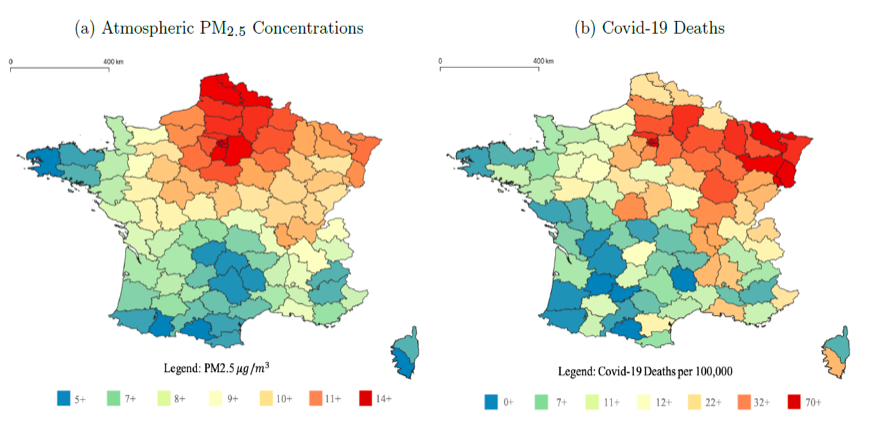
Editor’s note: This post is part of a series showcasing BSE master projects. The project is a required component of all Master’s programs at the Barcelona School of Economics.
Abstract
For patients infected by Covid-19, underlying health conditions are often cited as a source of increased vulnerability, of which exposure to high levels of air pollution has proven to be an exacerbating cause. We investigate the effect of long-term pollution exposure on Covid-19 mortality, admissions to hospitals and admissions to intensive care units in France. Using cross-sectional count data at the local level, we fit mixed effect negative binomial models with the three Covid-19 measures as dependent variables and atmospheric PM2.5 concentration (µg/m3) as an explanatory variable, while adjusting for a large set of potential confounders. We find that a one-unit increase in PM2.5 concentration raised on average the mortality rate by 22%, the admission to ICU rate by 11% and the admission to hospital rate by 14% (rates with respect to population). These results are robust to a large set of sensitivity analyses. As a novel contribution, we estimate tangible marginal costs of pollution, and suggest that a marginal increase in pollution resulted on average in 61 deaths and created a 1 million euro surcharge in intensive care treatments over the investigated period (March 19th – May 25th).

Conclusions
The study is a strong indication that air pollution is a crucial environmental factor in mortality risks and vulnerability to Covid-19. The health risks associated with air pollution are well documented, but with Covid-19 in the spotlight we hope to increase awareness of the threat caused by pollution, not only through direct increased health risks, but also through external factors, such as pandemics.
We show the aggravating effect of long-term pollution exposure to three levels of severity of Covid-19 symptoms in France: admission to hospitals for acute Covid-19 cases, admission to intensive care units for the most severe vital organ failures, and fatalities (all expressed per 100,000 inhabitants). Using cross-sectional data at the départemental (sub-regional) level, we fit mixed effect negative binomial models with the three Covid-19 measures as dependent variables and the average level of atmospheric concentration of PM2.5 (µg/m3) as an explanatory variable. We adjust for a set of 18 potential confounders to isolate the role of pollution in the spread of the Covid-19 disease across départements. We find that a one-unit increase in average PM2.5 levels increases on average the mortality rate by 22%, the admission to ICU rate by 11% and the admission to hospital rate by 14%. These results are robust to a set of 24 secondary and sensitivity analyses per dependent variable, confirming the consistency of the findings across a wide range of specifications.
We further provide numerical – and hence more tangible – estimates of the marginal costs of pollution since March 19th. Adjusting for under-reporting of Covid-19 deaths, we estimate that long-term exposure to pollution marginally resulted in an average 61 deaths across French départements. Moreover, based on average daily costs of intensive care treatments, we estimate that pollution induced an average 1 million euros in costs borne by hospitals treating severe symptoms of Covid-19. These figures strongly suggest that areas with greater air pollution faced substantially higher casualties and costs in hospital services, and raise concerns about misallocation of resources to the healthcare system in more polluted areas.
Our paper provides precise estimates and a reproducible model for future work, but is limited by the novelty of the phenomenon at the centre of the study. Our empirical investigation is restricted to the scope of France alone due to cross-border inconsistencies in Covid-19 data collection and reporting. Once Covid-19 data reporting is complete and consistent, we hope future studies will examine the effects of air pollution at a greater scale, or in greater detail. On the other hand, more disaggregated data – at the individual or hospital level – would allow more precise estimates and a better understanding of key factors of Covid-19 health risks and would also allow the use of surface-measured air pollution. Measured pollution data is available for France, but is inherently biased when aggregated at the départemental level, due to lack of territorial coverage. If precise data tracking periodic Covid-19 deaths becomes available for a wider geographic region, we specifically recommend a MENB panel regression incorporating a PCFE for spatially correlated errors. This will produce the most accurate estimates.
Going forward, more accurate and granular data should motivate future research to uncover the exact financial costs attributable to air pollution during the pandemic. Precise estimation of costs of Covid-19 treatments and equipment (e.g. basic protective equipment for personnel or resuscitation equipment), should feature in a more accurate cost analysis. Hospital responses should be thoroughly analysed to understand the true cost of treatments across all units.
It is crucial that the healthcare costs of pollution are globally recognised so that future policy decisions take them into account. Ultimately, this paper stresses that failure to manage and improve ambient air quality in the long run only magnifies future burdens on healthcare resources, and cause more damage to human life. During a global pandemic, the costs of permitting further air pollution appears ever more salient.
Connect with the authors
- Mattia Laudi, Research Assistant at IESE Business School (Barcelona)
- Hubert Massoni, Research Assistant at the French Ministry for the Ecological Transition (Paris)
- James Newland, Climate Strategy Analyst at Vivid Economics (London)
